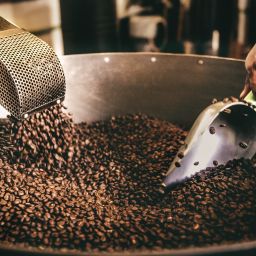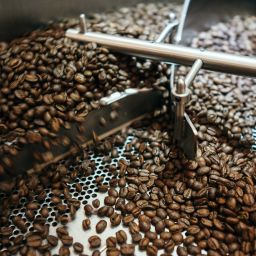
Coffee roasting is an art form that transforms the physical and chemical properties of green coffee beans into the aromatic brown beans we all know and love. This process is not just about heating beans; it’s a precise craft that unlocks the true flavor potential of coffee.
Understanding Coffee Beans
The Two Primary Types of Coffee Beans
Coffee beans come primarily in two varieties: Arabica and Robusta.
- Arabica Beans: Known for their sweet, soft taste and higher acidity, Arabica beans are considered superior in quality. They are typically grown at higher altitudes, which contributes to their rich flavor profile.
- Robusta Beans: These beans are stronger and more bitter in taste. They contain more caffeine and are generally considered to be of lower quality compared to Arabica. However, they are easier to grow and more resistant to pests and diseases.
The Importance of Bean Quality
The quality of the bean is a significant factor in roasting. High-quality beans yield better flavor and aroma. Factors affecting bean quality include the region of cultivation, climate, and harvesting methods. For beginners, it is recommended to start with high-quality Arabica beans for a more forgiving roasting process.
The Basics of Coffee Roasting
Understanding the roasting process is crucial for anyone looking to delve into the world of coffee roasting. Roasting is more than just browning the beans; it’s a complex chemical process that requires precision and attention.
Different Stages of Roasting
Coffee beans go through several stages during roasting, each imparting unique characteristics to the final product. Here are the primary stages:
- Light Roast: Beans are light brown and have a toasted grain taste with pronounced acidity. They lack oil on the surface and are ideal for milder coffee varieties.
- Medium Roast: This stage achieves a more balanced flavor, aroma, and acidity. Beans are medium brown with a stronger body compared to light roast.
- Dark Roast: Dark brown in color, often with an oily surface. These beans have a pronounced bitterness, with the original flavors of the bean taking a back seat to the flavors of the roasting process.
How Each Stage Affects Flavor
- Light Roast: Preserves the original character of the bean, ideal for highlighting the bean’s unique regional flavors.
- Medium Roast: Offers a more rounded flavor, often preferred for its balance of roast flavor and the intrinsic qualities of the bean.
- Dark Roast: Delivers a bold, rich taste, often with smoky or chocolaty notes, but can mask the bean’s natural flavors.
Roasting Equipment
For those new to coffee roasting, understanding the equipment required is a vital step. The market offers a range of equipment, from simple home roasting appliances to professional roasters.
Home Roasting Equipment
For beginners, home roasting equipment is an affordable and accessible option to start experimenting with roasting. These include:
- Air Roasters: Similar to popcorn makers, air roasters use hot air to roast beans evenly. They are great for achieving light to medium roasts.
- Drum Roasters: These mimic professional roasters and are suitable for larger batches. They provide more control over the roast, allowing for a range of light to dark roasts.
Professional Roasting Equipment
Professional roasters offer more precision and control, ideal for commercial purposes. These are more expensive and require a deeper understanding of the roasting process.
Essential Tools for Beginners
- Thermometer: Crucial for monitoring the temperature.
- Timer: Helps in tracking the roasting time.
- Cooling Tray: For quickly cooling down the beans post-roasting.
- Storage Containers: To store roasted beans and maintain their freshness.
The Roasting Process
Roasting coffee at home can be a highly rewarding experience. This section provides a step-by-step guide to help beginners navigate through their first roasting session.
Step-by-Step Guide to Roasting Coffee at Home
- Preparation: Begin by measuring out the green coffee beans. It’s important to roast only what you’ll use in a short period to ensure freshness.
- Preheating the Roaster: Preheat the roaster to the desired temperature. This varies depending on the type of roast you aim to achieve.
- Roasting: Add the beans to the roaster. Keep a close eye on the beans, listening for the ‘first crack’ – a sign that roasting has begun.
- Monitoring the Roast: Observe the color change from green to yellow to varying shades of brown. Use a thermometer to monitor the temperature.
- Deciding the Roast Level: Depending on your preference, stop the roast at the first crack for a light roast or let it continue to the second crack for a darker roast.
- Cooling the Beans: Once the desired roast level is achieved, remove the beans and cool them immediately. This stops the roasting process.
- Resting the Beans: Let the beans rest for several hours or overnight to allow the flavors to develop.
Tips for Controlling Temperature and Time
- Temperature Control: Higher temperatures speed up the roasting process but can lead to uneven roasts. Lower temperatures take longer but offer more control.
- Time Management: Roasting typically takes 10-15 minutes. Shorter roasting times yield lighter roasts, while longer times produce darker roasts.
Signs of Properly Roasted Beans
- Even Color: Uniform coloration indicates an even roast.
- Desired Crack Sounds: The first and second cracks are key indicators of roast stages.
- Aroma: The beans should emit a pleasant, strong coffee aroma.
Cooling and Storing Roasted Beans
After roasting, proper cooling and storage are essential to preserve the quality and flavor of the coffee beans.
Methods for Cooling Roasted Beans
- Spreading Out the Beans: Spread the beans on a flat surface like a baking tray. This helps in dissipating the heat quickly.
- Using a Cooling Tray: Some roasters come with a built-in cooling tray. These trays often have a stirring mechanism to cool the beans evenly and quickly.
Tips for Storage to Maintain Freshness
- Airtight Containers: Store the roasted beans in airtight containers to protect them from moisture and air.
- Cool, Dark Place: Keep the containers in a cool, dark place. Light and heat can degrade the quality of the roasted beans.
- Avoiding the Fridge: Contrary to popular belief, storing coffee in the fridge can introduce moisture and odors, adversely affecting the flavor.
Conclusion
Embarking on the journey of coffee roasting can be an enriching experience. It allows you to explore various flavors and customize your coffee experience. Remember, roasting is both a science and an art – it takes practice and patience to perfect. Don’t be afraid to experiment with different roast levels and beans to find your ideal cup of coffee.









